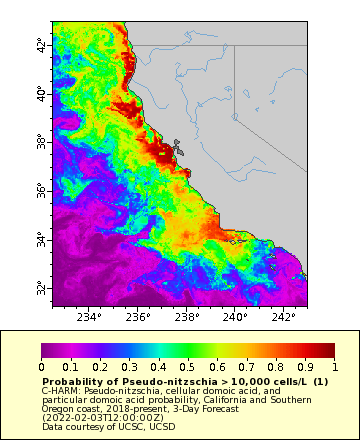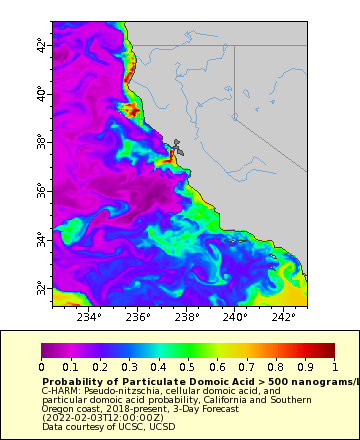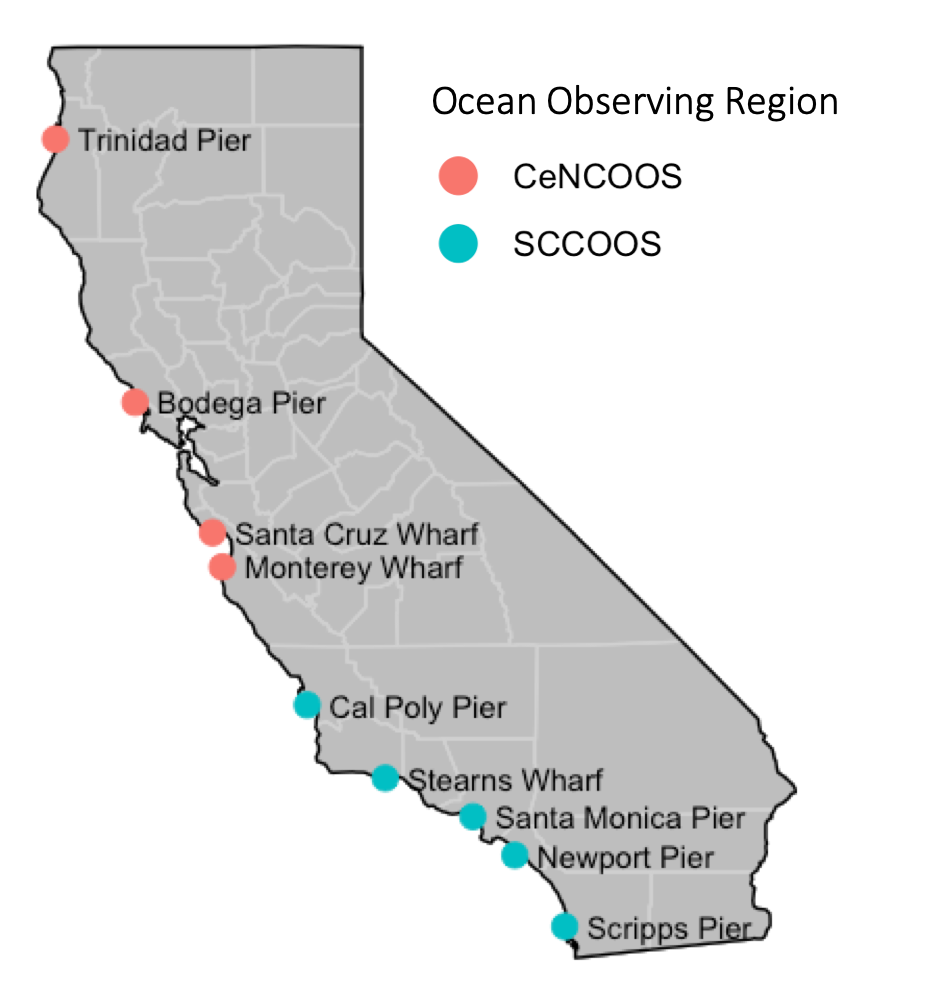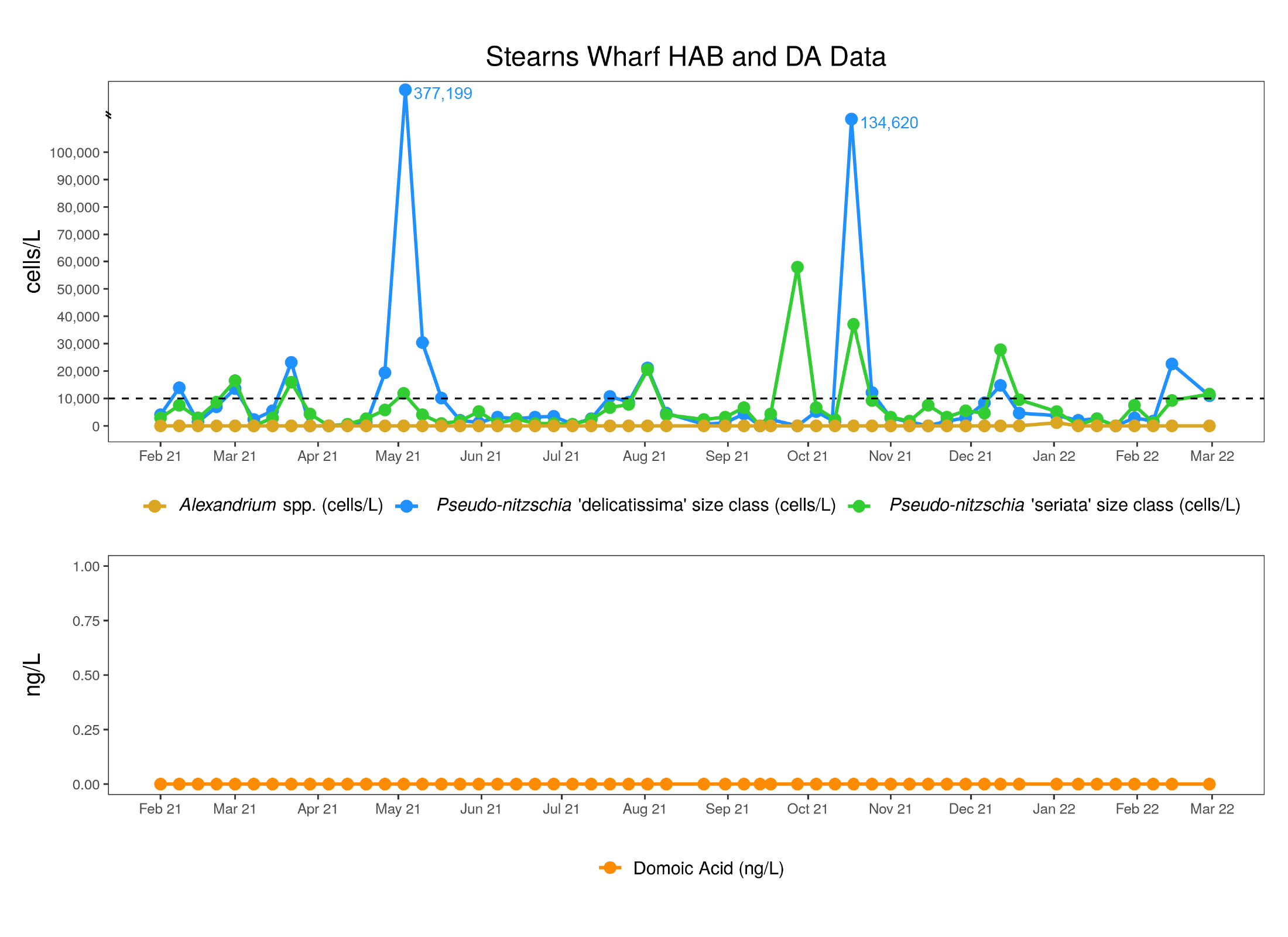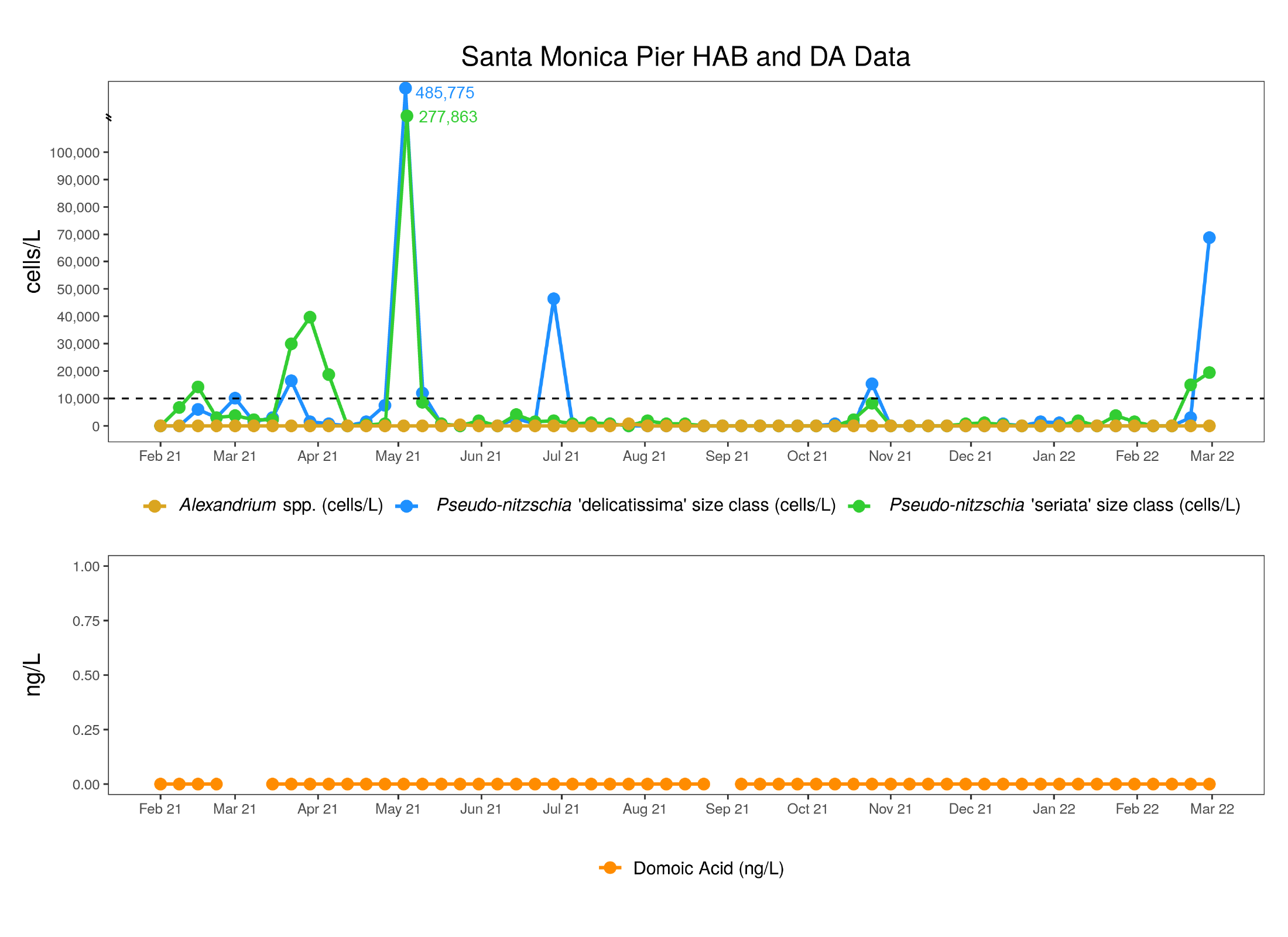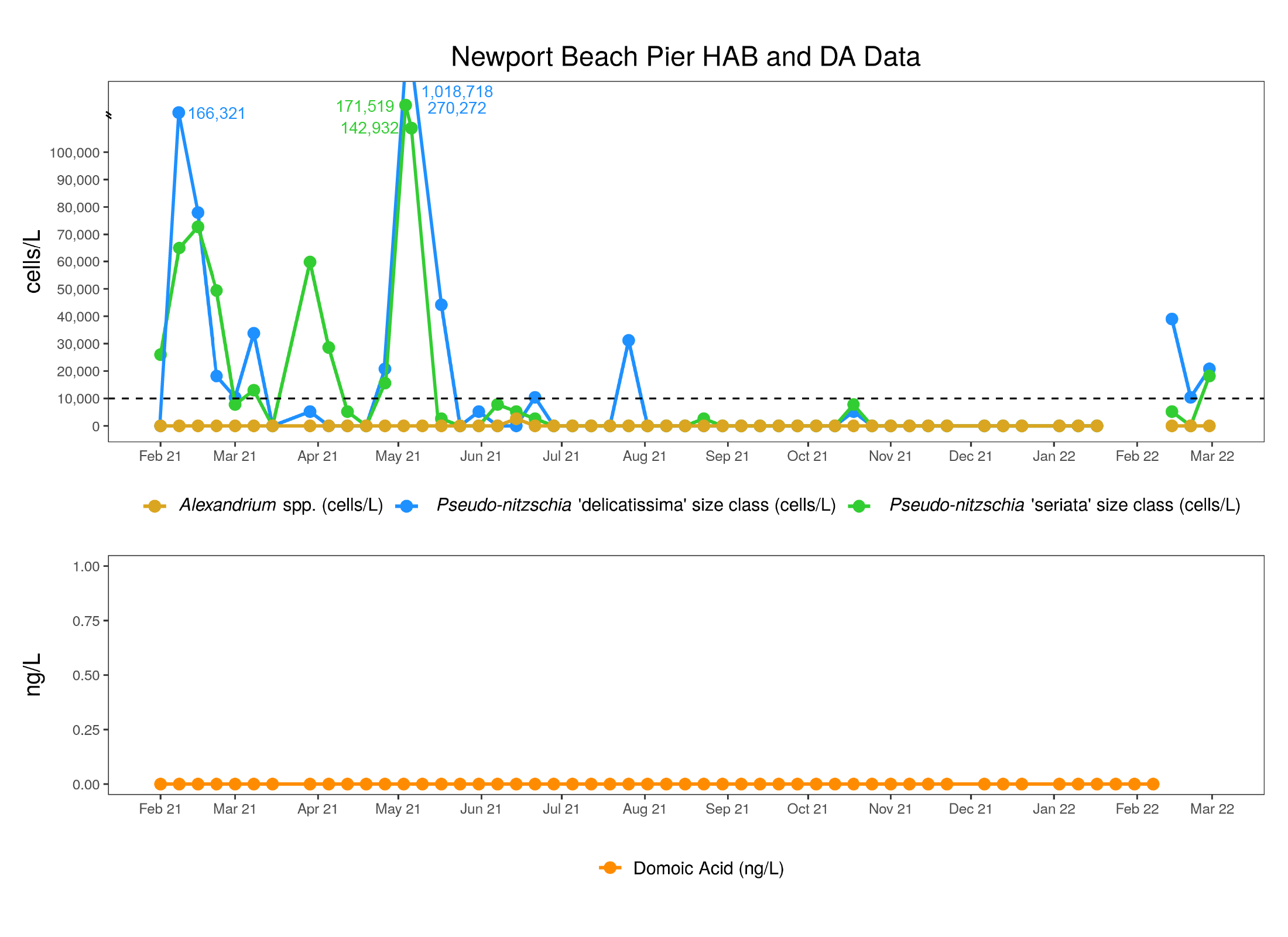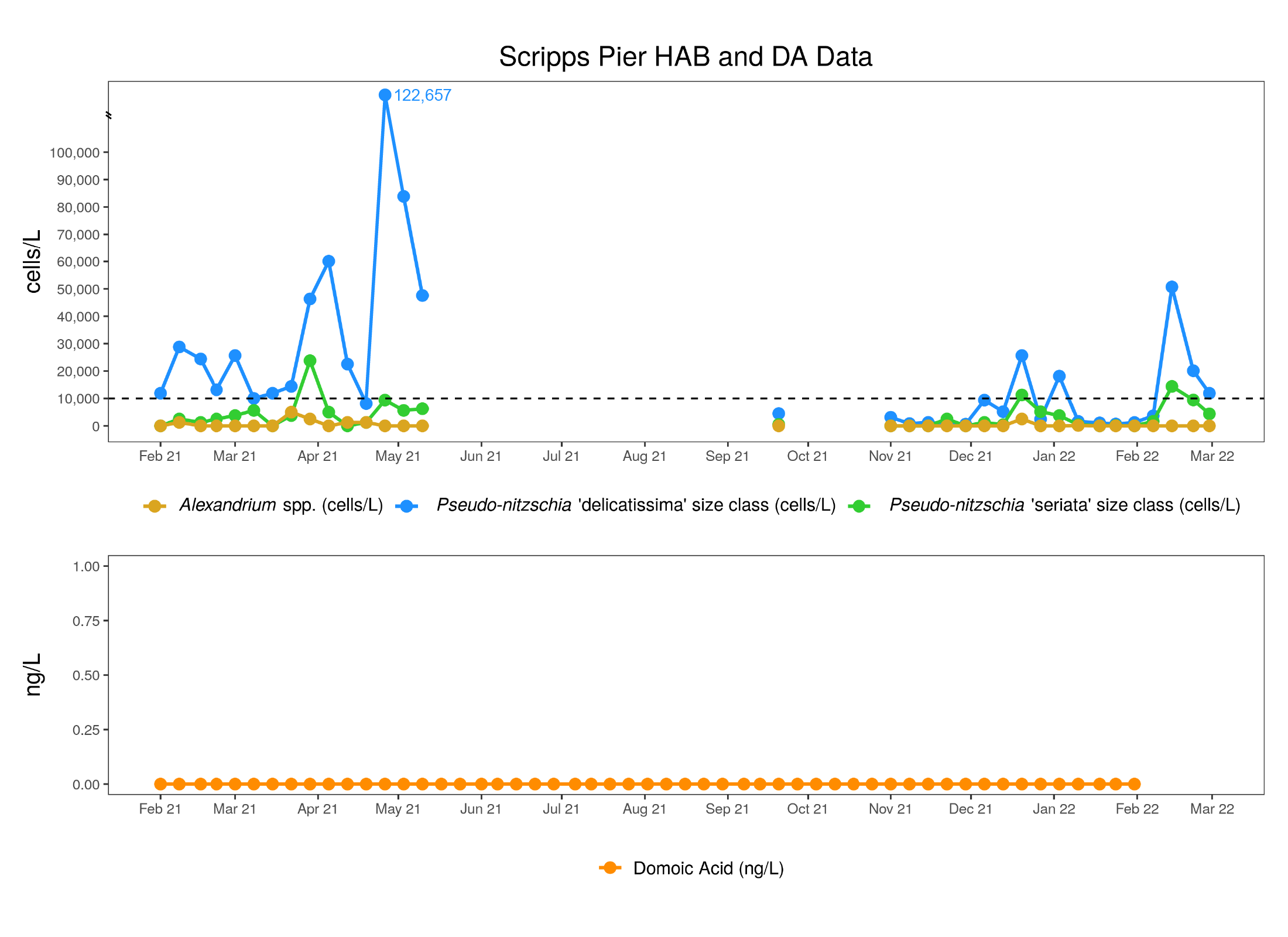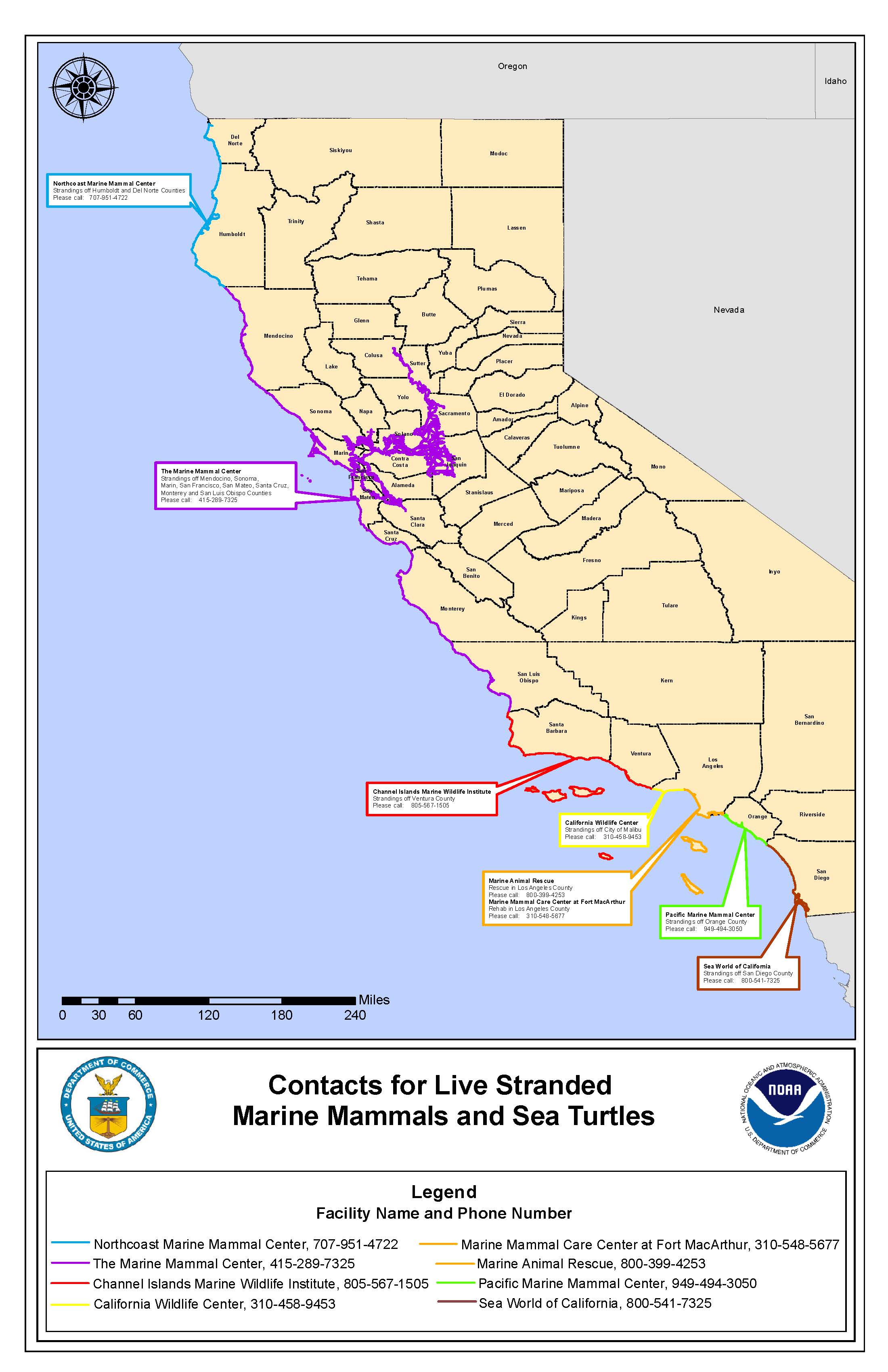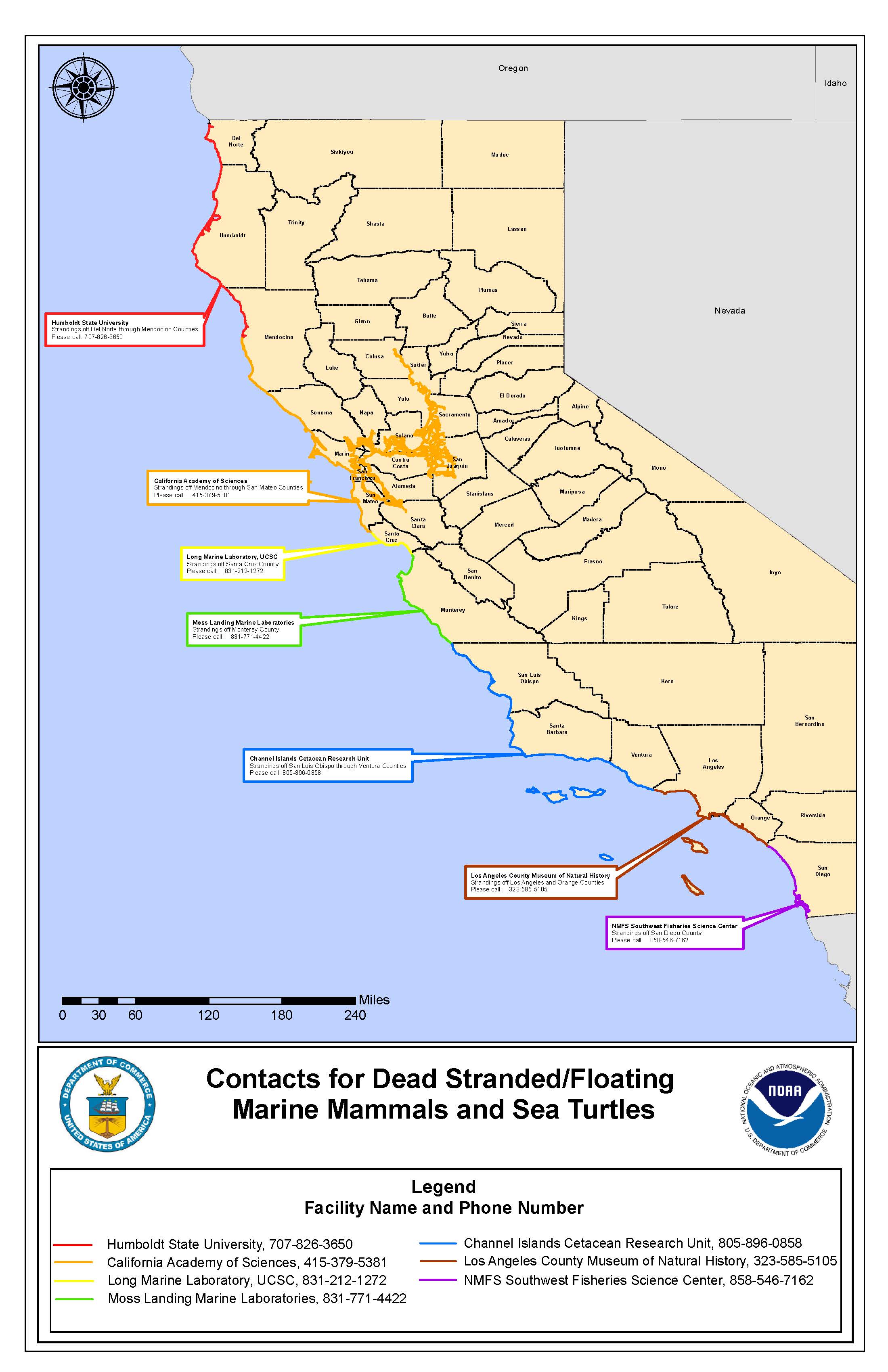FEBRUARY HIGHLIGHTS
Pseudo-nitzschia -
- C-HARM tells us where conditions are suitable for species of the diatom Pseudo-nitzschia spp. (all size classes) to grow well and where they might be more likely to produce the deadly neurotoxin, domoic acid (DA).
- C-HARM predictions for Pseudo-nitzschia spp. blooms in February were similar to January early in the month but then began to expand more offshore, with some intermittent contraction back to the coastline, particularly for northern California. This is more or less an expected climatologically for the month of February, when these blooms and toxic events do start to pick up again after the winter hiatus (which seems to be shorter and shorter in the last decade).
- Compared to the dearth of bloom activity in January at HABMAP pier sampling sites besides Scripps Pier, Pseudo-nitzschia spp. were starting to bloom at most sites in February. Pseudo-nitzschia spp. were detected just above or very near the bloom threshold of 10,000 cells/L for both size classes at all pier sites except Santa Cruz Wharf. This is a good indicator of the onset of the spring bloom period as all diatoms, not just Pseudo-nitzschia species, are poised for an increase in dominance as spring conditions become more permanent.
- Pseudo-nitzschia activity from CDPH sampling was not as consistent with HABMAP as it was in the previous month. Whereas HABMAP found fairly high levels of Pseudo-nitzschia from both size classes at most piers, the toxigenic 'seriata' size class was only observed as "Common" by the CDPH at several southern California sites in early to mid-February. However, it is important to note that much of the rise in Pseudo-nitzschia at HABMAP sites was seen later in the month, and CDPH does not do repeat sampling at a given site in a given month. This illustrates the importance of timing as well as the large horizontal variability that exists for plankton and the error inherent in single-site coastal sampling.
- C-HARM probabilities in February for particulate domoic acid (pDA) were higher overall relative to January with existing hot spots only enhanced in predicted intensity: the central coast outside of SF Bay/Half Moon Bay/Monterey Bay, fairly far offshore of the central San Luis Obispo coastline, Santa Barbara Channel (new region for February), southern portions of the Southern California Bight (much "hotter" in February according to C-HARM) and a nearshore swath of the North Coast from SF Bay to Humboldt (this region became potentially very "hot" later in January and C-HARM predicted that trend to continue into February).
- There are a few interesting differences between the cellular domoic acid (cDA) probabilities and the pDA probabilities for February. Regions of most concern based on how "hot" the cellular content was predicted to be were isolated to the north or offshore zone: 1) In mid- to late- February, a persistently high-probability patch fairly offshore of the central coast in the pelagic zone; 2) Early and late February, outside of the SF Bay; 3) Early and late February (with waning mid-month), Marin/Sonoma/Mendocino/Humboldt coastline to the border with Oregon.
- Domoic acid data are not yet fully available for HABMAP sampling sites in February. Of the samples analyzed so far for February (Santa Cruz Wharf, Stearns Wharf, Santa Monica Pier and Newport Beach Pier), no DA was detected.
- There were several cases of potential DA toxicosis recorded by marine mammal rescue centers in the month of February, one adult female from San Luis Obispo on the central coast where the persistent patch of potentially high pDA and cDA water was predicted offshore, and two animals from Mendocino that included an endangered Guadalupe Fur Seal. This is consistent with the very high pDA and cDA predictions from C-HARM for that stretch of coastline. Interestingly, the offshore extent and intensity of those DA predictions was maximal along the Mendocino coastline early and late in February, which corresponds to the timing of the two strandings. Another very significant event occurred in southern California, in the Los Angeles Orange County area, where PMMC recovered 9 juvenile sea lions and one adult female, some showing signs of massive seizures. This is consistent with domoic acid poisoning, and C-HARM predicted the region to be very "hot" during much of February, as often happens this time of year at the onset of the spring bloom period.
- CDPH health advisories have been stable. The December 16th advisory is still in effect to not eat razor clams caught recreationally in Del Norte County due to the threat of ASP from domoic acid; this may be connected to the high DA predictions coming from the North Coast in previous months and the southern Oregon hot spot noted in December.
Alexandrium -
- CDPH noted that Alexandrium spp. were rare or absent at their sampling sites, consistent with HABMAP sampling which found no Alexandrium spp. at pier sites in February. There are currently no advisories for Paralytic Shellfish Poisoning.
*Please note that HABMAP sampling, CDPH sampling, and marine mammal rescues have been greatly reduced in response to COVID-19 safety measures.
Summary written by Clarissa Anderson on March 24, 2022
Note that data for some stations are not shown because they are not yet recorded in the public HABMAP archive.
Differentiating Pseudo-nitzschia species by light microscopy is difficult. For this reason, Pseudo-nitzschia "seriata" does not refer to an actual species but rather the larger size class of Pseudo-nitzschia, which is generally a more toxigenic group of species. Alternatively, Pseudo-nitzschia "delicatissima" refers to the smaller size class that is generally non-toxigenic. The dashed line on the plots demarcates the 10,000 cells/L "bloom" threshold designated here for Pseudo-nitzschia populations only.
More information and data visualizations on the statewide HAB network and forecasting system can be found on the California HABMAP website and on the SCCOOS Harmful Algal Bloom page.
Santa Cruz Wharf
Four water samples were collected at Santa Cruz Wharf in February. Molecular probes for toxigenic Pseudo-nitzschia in the "seriata" class are conducted for this site, and was detected once on February 23, below the bloom threshold. Alexandrium spp. and domoic acid were not detected.
The Santa Cruz Wharf shore station is supported by CeNCOOS PI Raphael Kudela at UCSC.
Cal Poly Pier
Four water samples were collected at Cal Poly Pier in February, though the last sample results (February 28) are pending. Pseudo-nitzschia "delicatissima" was detected three times (February 7, 14, 21), all below the bloom threshold. Pseudo-nitzschia "seriata" was also detected three times, with February 21 above the threshold. Alexandrium spp. were detected once on February 21. Domoic acid was not detected.
Cal Poly Pier shore station is supported by SCCOOS and PIs Ryan Walter and Ally Pasulka at Cal Poly.
Stearns Wharf
Three water samples were collected at Stearns Wharf in February. Pseudo-nitzschia "delicatissima" was detected on each occasion (February 7, 14, 28), with the last 2 samples above the bloom threshold. Pseudo-nitzschia "seriata" was also detected on each occasion, with the February 28th sample above the threshold. Alexandrium spp. and domoic acid were not detected.
Stearns Wharf is supported by SCCOOS and PIs Mark Brzezinski and Libe Washburn at UCSB.
Santa Monica Pier
Four water samples were collected at Santa Monica Pier in February. Pseudo-nitzschia "delicatissima" was detected twice (February 21, 28), with the last sample above the bloom threshold. Pseudo-nitzschia "seriata" was also detected on February 21 and 28, with both samples above the bloom threshold. Alexandrium spp. and domoic acid were not detected.
The Santa Monica Pier shore station is supported by SCCOOS and PI Rebecca Shipe at UCLA.
Newport Beach Pier
Four water samples were collected at Newport Beach Pier in February, though the February 7 samples are pending analysis. Pseudo-nitzschia "delicatissima" was detected on each occasion (February 14, 21, 28) above the bloom threshold. Pseudo-nitzschia "seriata" was detected twice (February 14, 28), with the last sample above the threshold. Alexandrium spp., were not detected. Domoic acid was not detected on February 7 and the remaining samples are pending analysis.
Newport Beach Pier is supported by SCCOOS and PI David Caron at USC.
Scripps Pier
Four water samples were collected at Scripps Pier in February. Pseudo-nitzschia "delicatissima" was detected on each occasion (February 7, 14, 22, 28), with the last 3 samples above the bloom threshold. Pseudo-nitzschia "seriata" was also detected on each occasion, with only the February 14 sample above the bloom threshold. Alexandrium spp. were not detected and domoic acid results are not available.
Scripps Pier is supported by SCCOOS and PIs Melissa Carter and Clarissa Anderson at UCSD.
CDPH observations for Pseudo-nitzschia "seriata" and Alexandrium spp.
View the interactive map and data table of California Department of Public Health (CDPH) data from January 2019 to present, developed by SCCOOS, below. Or, view CDPH Toxic Phytoplankton Observations Map with layers of Pseudo-nitzschia and Alexandrium spp. as well as other phytoplankton species observations (in the pop-up windows).
Data are provided by the Environmental Management Branch of the CDPH. Please note, starting in July 2019, CDPH moved to only reporting Pseudo-nitzschia of the seriata complex and not all Pseudo-nitzschia spp. as previously provided.
Please email CDPH at Susan.Paulukonis@cdph.ca.gov for any potential marine HAB-related illness in humans.
From February 1-28 2022, water samples were collected by volunteers and sent to the California Department of Public Health (CDPH) for analysis.
Pseudo-nitzschia "seriata" group was detected in 47 of the 81 samples:
Pseudo-nitzschia "seriata" was detected at "Common" density levels on 4 occasions:
- 2022-02-04 16% Bolsa Chica
- 2022-02-08 30% Point Dume, offshore
- 2022-02-10 10% Orange County, OFFSHORE
- 2022-02-11 15% Bolsa Chica
Pseudo-nitzschia "seriata" was detected at "Present" density levels on 22 occasions:
- 2022-02-02 6% Santa Barbara, Mohawk Reef
- 2022-02-07 1% Morro Bay, Boat Launch
- 2022-02-07 3% Santa Cruz, Seacliff Pier
- 2022-02-07 5% Pismo Pier
- 2022-02-07 5% La Jolla, Scripps Pier
- 2022-02-08 5% Catalina Island, Avalon Bay
- 2022-02-09 1% Santa Cruz, Capitola Pier
- 2022-02-09 2% Santa Monica Bay
- 2022-02-09 2% Crystal Cove SB, OFFSHORE
- 2022-02-14 4% La Jolla, Scripps Pier
- 2022-02-15 5% Humboldt Bay, Indian Is. Ch.
- 2022-02-16 1% Santa Monica Bay
- 2022-02-21 3% Tomales Bay, Lease #M430-15
- 2022-02-21 4% Morro Bay, Boat Launch
- 2022-02-22 7% La Jolla, Scripps Pier
- 2022-02-23 2% Monterey Bay, Commercial Wharf
- 2022-02-24 2% Imperial Beach Pier
- 2022-02-25 4% Santa Barbara Ch., Naples Pt
- 2022-02-27 1% Tomales Bay, Lease #M430-15
- 2022-02-28 1% Morro Bay, Boat Launch
- 2022-02-28 2% Bodega Harbor, USCG Dock
- 2022-02-28 4% La Jolla, Scripps Pier
Pseudo-nitzschia "seriata" was detected at "Rare" density levels on 21 occasions:
- 2022-02-02 0.5% Santa Cruz Wharf
- 2022-02-06 0.5% Pacifica Pier
- 2022-02-10 0.5% Goleta Pier
- 2022-02-10 0.5% Santa Barbara Ch., Naples Pt
- 2022-02-10 0.5% San Clemente Pier
- 2022-02-12 0.5% Pacifica Pier
- 2022-02-13 0.5% Trinidad Pier
- 2022-02-14 0.5% Morro Bay, Boat Launch
- 2022-02-14 0.5% Tomales Bay, Lease #M430-15
- 2022-02-14 0.5% Mendocino, Noyo Harbor
- 2022-02-16 0.5% Monterey, Stillwater Cove
- 2022-02-16 0.5% Santa Cruz, Capitola Pier
- 2022-02-16 0.5% Goleta Pier
- 2022-02-17 0.5% Santa Cruz, Seacliff Pier
- 2022-02-18 0.5% Bolsa Chica
- 2022-02-22 0.5% Tomales Bay, Lease #M430-15
- 2022-02-22 0.5% Mendocino, Noyo Harbor
- 2022-02-22 0.5% Pismo Pier
- 2022-02-26 0.5% Pacifica Pier
- 2022-02-27 0.5% Palos Verdes, OFFSHORE
- 2022-02-27 0.5% Cayucos Pier
Alexandrium spp. were detected in 13 of the 81 samples:
Alexandrium spp. were not detected at "Common" density level.
Alexandrium spp. were not detected at "Present" density levels.
Alexandrium spp. were detected at "Rare" density levels on 13 occasions:
- 2022-02-10 0.5% Goleta Pier
- 2022-02-10 0.5% Santa Barbara Ch., Naples Pt
- 2022-02-14 0.5% Morro Bay, Boat Launch
- 2022-02-14 0.5% Tomales Bay, Lease #M430-15
- 2022-02-14 0.5% La Jolla, Scripps Pier
- 2022-02-15 0.5% Richmond, Marina Bay Harbor
- 2022-02-15 0.5% Bodega Harbor, USCG Dock
- 2022-02-18 0.5% Bolsa Chica
- 2022-02-21 0.5% Morro Bay, Boat Launch
- 2022-02-22 0.5% Pismo Pier
- 2022-02-24 0.5% Hunter Rock, north
- 2022-02-25 0.5% Santa Barbara Ch., Naples Pt
- 2022-02-28 0.5% La Jolla, Scripps Pier
CDPH and OEHHA Health Advisories
December 16. The California Department of Public Health (CDPH) is advising consumers not to eat sport-harvested razor clams from Del Norte County due to dangerous levels of naturally occurring domoic acid, also referred to as Amnesic Shellfish Poisoning, being detected.
November 29. The California Department of Public Health (CDPH) has lifted the shellfish safety notification for Dungeness crab caught in state waters from the Sonoma/Mendocino County Line (38° 46.125' N. Latitude) to Point Reyes (38° N. Latitude) in Marin County.
November 5. Due to the detection of elevated levels of domoic acid, a naturally occurring toxin, the California Department of Public Health (CDPH) is warning consumers not to eat the viscera (internal organs) of Dungeness crab caught in coastal waters.
For the latest closures and updates, please visit the CDPH Health Advisories page as a central location of information related to CDPH health advisories. Also available is a map showing the current CDPH Recreational Bivalve Shellfish Advisories (see below).
The HAB-related illness workgroup has developed a new webpage for marine HAB-related illness tracking work (https://oehha.ca.gov/fish/general-info/marine-harmful-algal-bloom-hab-related-illness-tracking).
Domoic acid (DA) is a potent neurotoxin produced by some diatom species of the genus Pseudo-nitzschia. Species exposed to DA can result in seizures, epilepsy, cardiomyopathy, and death depending upon the ingested dose. DA toxicosis commonly occurs in California Sea Lions (Zalophus californianus), presumably due to a combination of foraging behavior and seasonal movements. The Marine Mammal Center (TMMC), Channel Islands Marine Wildlife Institute (CIMWI), California Wildlife Center (CWC), Marine Mammal Care Center Los Angeles (MMCC-LA), Marine Animal Rescue (MAR), the Pacific Marine Mammal Center (PMMC), and SeaWorld act like an emergency room by working to rescue and rehabilitate sick and injured marine mammals, seabirds, and sea turtles.
SeaWorld, MMCCLA, CWC, MAR, and CIMWI did not record any strandings due to suspected domoic acid in February 2022.
February strandings due to suspected DA toxicosis occurred in the following counties:
- San Luis Obispo (TMMC)
- February 1 - adult, female, California Sea Lion
- Mendocino (TMMC)
- February 8 - adult, female, California Sea Lion
- February 23 - adult, female, Guadalupe Fur Seal
The PMMC rescued an adult Female California Sea Lion with suspected of DA poisoning, results pending. PMMC also had 9 deceased sea lions picked up in Crystal Cove, Newport Beach, and Laguna Beach since February 16th. DA results are pending.
At this time we do not have data from the North Coast Marine Mammal Center.
Please subscribe to CA HAB Bulletin listserv to receive the monthly CA HAB Bulletin.

